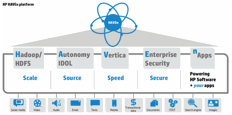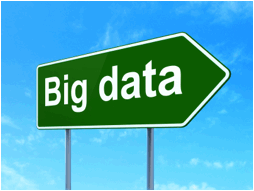I met Pramod Singh in 2001, when he was a data miner at Compaq Computers. Second time we met the day after HP announced its acquisition. His data background goes back much farther, his current position much more exalted and his future is anybody’s guess. This guy knows data.

|
| Photo caption: Pramod Singh Director: Digital and Big Data Analytics, HP |
A son of a math professor, Pramod got his MBA in marketing from the University of Jammu in India. From there, he picked up a PhD in Mathematics, eventually, from the University of Arkansas. But it wasn’t a linear progression.
Three hours before his PhD prelims qualifier, he got a call from Wal-Mart Information Systems, unaware that a friend of his had created and submitted a resume in his name. This was late 1996 and Pramod hadn’t even started his PhD in math. He knew next to nothing about IT and data mining.
Seeing the Potential in Data
Wal-Mart had recently signed contracts with a (then) small company in Little Rock called Axiom and an AI company. They were also sitting on a treasure trove of demographic data. Maybe, they thought, this math guy could figure out how to mine this data. And so, Pramod became the first data miner at Wal-Mart.
Back then, every Wal-Mart store in the country had exactly the same product assortment. The only difference was the number of those items they could proportionally get onto the shelves – a function of available space. This was the perfect opportunity for a young man who knew very little, but was young enough to be naively brave. He felt it might be better to employ clustering analytics, looking for buying patterns. Perhaps, he reasoned, that buying habits were different in different sized stores.
 “We looked at Pantene One and different brands of Head and Shoulders through the lens of store sales and because this had never been done, we were able to try a lot of different clustering techniques.”
“We looked at Pantene One and different brands of Head and Shoulders through the lens of store sales and because this had never been done, we were able to try a lot of different clustering techniques.”
Pramod found some interesting geographic clusters in the data set and found that data was corrupted and the data model was misconfigured. He found that there were distinct buying patterns, unique to the North East that popped up in the South East. It simply didn’t make sense.
“We were in rural Arkansas and this was new thinking. I was lucky to have found a very receptive shampoo and conditioner buyer. I walked up to this buyer, and just said, ‘Man, is there something wrong here? I don’t know why this is happening.” And this mid-fifties buyer looks at me and says, ‘Yeah, I know what it is. Snowbirds. When these people go south for the winter, they take their buying patterns with them.”
This was Pramod’s first practical application of data mining to the real world, and it opened the door to practical testing. He was able to change the product ratios in smaller stores in a variety of regions. “Within three months, we proved that this thing worked and got 4 to 5% lift in sales with the right assortment of products in the right location.”
Pramod tested three or four product categories and was finally called into the CIO’s office and asked to roll it out for all of Wal-Mart. “So here I am 28 or 29 years old, with no real industry experience, making big bet decisions for one of the world’s biggest companies.”
Based on just a hunch and a few tests, Pramod created an assortment planning system which Wal-Mart rolled out to all stores within a year. “I really love going into Wal-Mart now. After 15 years, I can see that the end caps are still working the way I set them up!”
Pramod found himself training trainers in clustering techniques and entertaining data and merchandizing executives from major packaged goods companies. It was a heady time, but just the start.
Getting Online
The birth of his daughter and the prospect of exercising his math education even more, prompted Pramod to spread his wings and move from Arkansas to the Austin, Texas. Compaq had built an advanced data mining center and were looking for somebody to lead it.
![]() Within months the data mining center turned almost all of its attention to ecommerce analytics, reporting straight to the CIO. This was close enough to the birth of web analytics, that Pramod found himself wrestling with. The big questions of the day: Was log file analysis enough or could client side tagging improve the dataset? Should a session time out after 30 minutes or an hour of inactivity? Was there a way to figure out which ads were driving sales?
Within months the data mining center turned almost all of its attention to ecommerce analytics, reporting straight to the CIO. This was close enough to the birth of web analytics, that Pramod found himself wrestling with. The big questions of the day: Was log file analysis enough or could client side tagging improve the dataset? Should a session time out after 30 minutes or an hour of inactivity? Was there a way to figure out which ads were driving sales?
By the time of the HP merger, Pramod’s team was steeped in landing page and customer experience optimization, doubling the conversion rate in consumer sales. They parsed out the shopping and buying process, estimated the lift they could achieve at each step, and then calculated the confidence they had in the anticipated impact to determine which part of the customer journey to optimize first. They had thought it through clearly and completely back when everybody else was still wondering if it was possible.
At HP, the Compaq analytics team became HP’s global Customer Knowledge Management & Analytics group. Pramod worked there with Seth Romanow who would later co-found the Digital Analytics Association. Pramod tells the story of how Seth met “this kid from Omniture” at the eMetrics Summit, and worked out a world-wide license agreement over sushi. Josh James wasn’t even 30 and was already well on his way to taking over the web analytics industry.
The global roll out provided some eye-opening lessons in corporate life, technology and analytics but Pramod’s career switched to a new track after (literally) running into Randy Mott who had been CIO at Wal-Mart when Pramod was there. Randy had since been CIO at Dell and at this point, was CIO at HP.
Boom Times
“Hey, Pramod,” Randy had said, “You need to come and work for me and show the value of analytics and built out an HP-wide analytics platform so hundreds of people can use it.” This is where globalization, nationality, and Big Data all fit together in a surprising way.
“We had to figure out how to optimize the network topology to support people running analytical processes in the data centers in Austin and Houston from all over the world. And at this point, nobody had thought through how to go and get on the Big Data bandwagon from a technology perspective.”
Big Data at HP
“I was born in New Hampshire but my parents are Indian and live in India now. HP also has a big analytics team in Bangalore. The team was keen to expand their Digital and Big Data Analytics capabilities. . They asked if I will join them and I did. Big leap of faith to move my family, but the opportunity was just too much to pass up and I joined as the director of the Digital and Big Data Center of Excellence.”
Pramod’s background in web analytics helped; his group runs all the digital analytics practice. That includes running all of HP’s e-commerce analytics, all of social media analytics, campaign analytics, search analytics as well as building out the big data practice.
 “Global Analytics goes across the entire food chain. That is: supply chain, sales, marketing, finance, HR, operational analytics and all of that. So while all that was happening, HP started with their big data product strategy. And it stormed the market as HAVEn. The H is for Hadoop; A is Autonomy; V is Vertica; E is Enterprise Security and the little n is n-apps which caters to analytical solution you build on top of that.”
“Global Analytics goes across the entire food chain. That is: supply chain, sales, marketing, finance, HR, operational analytics and all of that. So while all that was happening, HP started with their big data product strategy. And it stormed the market as HAVEn. The H is for Hadoop; A is Autonomy; V is Vertica; E is Enterprise Security and the little n is n-apps which caters to analytical solution you build on top of that.”
Pramod’s team was the alpha site for all of the above. “I think we came in handy there because we were working on real business problems in the space. Typically the way you do analytics for data, you know, your data arrives from the warehouse, you bring it out into SasS form or some other form, do something, take it back.
“For example, one of the interesting spaces is around our printing business now that these are web connected printers collecting web logs. They do not provide identifiable personal customer information. We’re collecting a lot of data and it’s growing at a terabyte a day. This calls for a whole new class of analytics that wasn’t possible about three, four years ago.
“But with Vertica in this ecosystem, we have hooks into R. And then we can write user defined functions and actually take a full-blown analytical model and run it in database. So instead of taking data to the analytics, you can actually take analytics to the data. And that is kind of a game changer because now you can do real time analytics.”
However, Pramod had to get people trained on the tools and then train the trainers. In a little over a year, they built up the biggest Big Data Analytics Center of Excellence (COE) in HP. The new challenge was not to just build the right skillset among the people but to also orient them to be influencers by exhibiting thought leadership. He focused on mobilizing the COE to foster and grow their intellectual property through ideation and patent generation. “There are a hundred plus people on my team, and we have presented alongside Meg Whitman in our executive briefing room to external customers, showing the business value of developing big data solutions. It’s very fulfilling to share the stage with your CEO.”
Pramod’s team sits in an organization called Corporate Strategy. The organization reports directly into Mohamad Ali, HP’s Chief Strategy Officer and focuses on digital marketing effectiveness (social media, web analytics, e-commerce, etc.).
Big Data Integration
When I ask Pramod if they are actually integrating all of that data, he responses enthusiastically, “Oh absolutely, absolutely, all depending on the business problems we have. For example, we are able to integrate the social media data with ecommerce and campaign data. We are able to integrate customer demographics that we have coming through the Axiom’s of the world.

“HP invested quite a bit in the earlier days on creating an enterprise data warehouse. Old school was all about getting all the data of the enterprise unto one platform. That works very, very well for a structured data, right around supply chain and all that. But Big Data has turned data warehousing upside down.
“But over the last two or three years, we’re getting web data and more data from outside the enterprise like social media data, and we need a new way to approach how we use it; which settings we use and so on.
“For example, we have moved our click stream data into our Big Data farm. It lands in a Hadoop cluster and then moves into a Vertica environment where we have created an analytical sandbox which integrates all of this disparate data.
“What is challenging, but also a huge opportunity, is new classes of intelligence we are generating using social media data. If you want to engage in the science of social influence, you have to make a lot of decisions about which data you are going to bring in – because you can’t have all of it inside the company – and then how you are going to structure it. You have to decide what model to propose for a social media stack, bring in just the relevant data, and then abstract it to the point that you can join it with other data.”
This is an organization – and a team – and an individual with a clear data vision, a solid strategy and a tested set of high-powered tools. My next question for Pramod was about adoption on the business side. How quickly is HP, as an enterprise, becoming data driven?
“Yes, HP is a giant enterprise. We see the entire adoption spectrum. Even with close to a thousand people, we still haven’t explored the unexplored. There are plenty of teams that live and die by analytical insight, but there is a lot more work we can do – a lot of opportunity.”
“I’m seeing a fundamental shift compared to just five years ago. The amount of upward mentoring or upward selling we had to do has dramatically declined. We’re at a point where everybody is thinking it’s the right thing to do, just tell me how to do it. The skepticism is gone. It also helps to have the CEO firmly on our side.”
Deriving Insights from Data
Pramod has no end of stories where data has come to the aid of intuition. (He is quick to counsel against blindly following any data.)
The most fundamental question in marketing is “Which half of my advertising dollar is wasted?” That question was brought to the fore by a VP responsible for sales to SMB’s (small and medium businesses). The VP didn’t have the budget to reach out to all 21 million SMBs in the U.S. and asked for help.
 Pramod has pulled out his trusty clustering analytics to look at current customers rather than prospective customers. Armed with deep data about sales history (what they bought, how much they bought, how often they bought), they brought in firmographic data (industry segment, how many employees, how much revenue, etc.). They then layered in the digital analytics data (click stream data, how many times they came to the site, how long were they on, did they buy online, were there email conversations, etc.).
Pramod has pulled out his trusty clustering analytics to look at current customers rather than prospective customers. Armed with deep data about sales history (what they bought, how much they bought, how often they bought), they brought in firmographic data (industry segment, how many employees, how much revenue, etc.). They then layered in the digital analytics data (click stream data, how many times they came to the site, how long were they on, did they buy online, were there email conversations, etc.).
“My team dug through the data to see if they could classify their SMB customers into clear clusters. And, as math PhD’s sometimes do, we came up with clusters which mathematically make sense, but business-wise make no sense at all. A classic problem.
“So one evening, I’m driving back home, and I thought that maybe the most important thing that distinguishes these buyers is not their company size or geography, but the strongest signal we have, which is their behavior. These people clicked on these things in order to buy these products. And if we can recognize their interaction behavior, maybe we can influence it.
His team looked at specific products purchased and the classic recency, frequency and monetary value. They turned their attention on finding clusters that were not just mathematically distinct, but distinct in a way that marketing could do distinct things for them.
“If marketing cannot take differentiated actions against a cluster, I don’t think you are successful, even though mathematically you may have an elegant solution.
“We discovered two, most compelling clusters. One cluster was almost half the population, but less than 10% of the revenue. Then we found a cluster which was only 6% of the population, but they accounted for something like 48% of the revenue. That was a big ah-hah moment.
“This was still the raw data so we took it back to the business and interacted back and forth with those guys. We realized we were on to something, but we did not know why they were different. So we pulled a random sample from the five clusters we had created and actually conducted a survey; a real, physical survey with questions around their buying patterns. It was a half an hour survey and a very, very interesting story started to evolve.
 “We were able to figure out who made up that first segment, and the other 6% who accounted for so much of the revenue. So we built up a predictive model using our firmographics using these clusters and the target variables to score all SMBs in the U.S., and found the ones which were closest to our ‘Vanguards’ i.e., companies that are best at what they do. Now, our marketing folks could customize their messaging and instead of going after 20.5 million prospects, they could focus their attention and limited resources on just the cluster we handed them. That was documented to have an incremental impact of over $100 million for HP.
“We were able to figure out who made up that first segment, and the other 6% who accounted for so much of the revenue. So we built up a predictive model using our firmographics using these clusters and the target variables to score all SMBs in the U.S., and found the ones which were closest to our ‘Vanguards’ i.e., companies that are best at what they do. Now, our marketing folks could customize their messaging and instead of going after 20.5 million prospects, they could focus their attention and limited resources on just the cluster we handed them. That was documented to have an incremental impact of over $100 million for HP.
Challenges and Opportunities
When asked about upcoming challenges and opportunities, Pramod sees only opportunity. He’s very enthusiastic about non-traditional non-enterprise data. “We have tapped into social media influencers to arrive at a reasonable price to pay for quality systems and services on the supply chain side. That is pretty radical. Who would have thought that you could parse random chatter for business value?
“I can even analyze social data about other companies to see how their employees are feeling about them. If I have to decide whether to partner with company A or B, this can be a big factor. Are their managers engaged and motivated?
“Marketing is going to change. Rather than classic things like surveys, user groups and spending millions of dollars to test marketing, now you can figure out what people are saying in public between your announcement and launch and can, with reasonable accuracy, predict how much you will sell.
“The same way, I can predict how much of any given product any company is going to sell”.
Even analytics is changing as a result of big data. In the ’80s, we were taught to be very, very precise to get a good sample. Nowadays with the kind of technology we have and the hardware becoming so cheap, you can run through billions of rows of data.
“In a few years, understanding data and making intelligent decisions based on data will be the game changer for organizations.”
As data gets bigger, the world is getting smaller and things are moving faster. Where will Pramod be in ten years? Stay tuned.
By: Jim Sterne, Founder, eMetrics Summit
